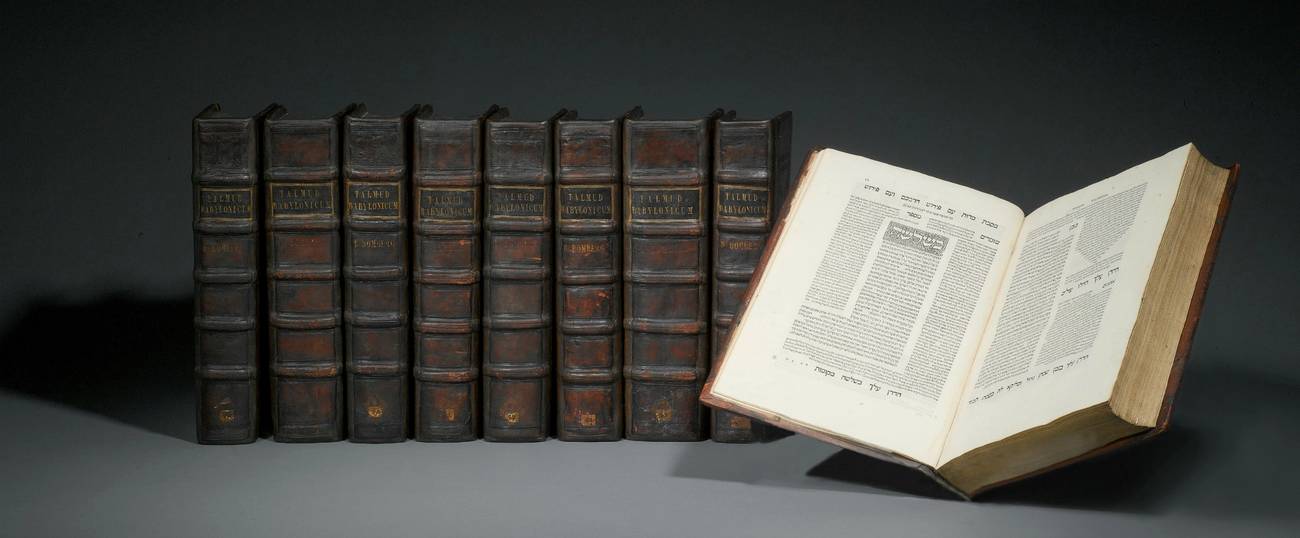New York Businessman Leon Black Buys Bomberg Talmud for $9.3 Million
A number of medieval Hebrew texts from the Valmadonna Trust Library were sold at Sotheby’s on Tuesday




A pristine Daniel Bomberg Babylonian Talmud—a cornerstone of the Valmadonna Trust Library, a private collection consisting now of more than 11,000 “early Hebrew books, manuscripts, and broadsides—an exhaustive array of Mishnaot, siddurim, Haggadot, alef-bet tables, and ephemera that includes rare items printed on blue paper, vellum, and silk”—sold for more than $9 million dollars at a Sotheby’s auction in New York on Tuesday. A source has confirmed the buyer is Leon Black, a New York businessman who founded Apollo Global Management, a private equity firm.
According to a press release from the auction house, the sale is “a new world auction record for any piece of Judaica.”
There are only 14 complete sets still around of the 16th century Talmud’s issued by Daniel Bomberg, “a Christian from Venice who was the first to issue a complete edition of the work, starting in 1520,” reported Tablet contributor Allison Hoffman in 2009. In her article, “Treasure Trove,” Hoffman details just how Jack Lunzer, the custodian of the Valmadonna Trust Library, came to own this copy of the Talmud, which is a fascinating tale of persistence in and of itself:
The story of one of the greatest coups in the history of book collecting began, as it happens, with a mistake. In 1956, an industrial diamond dealer and bibliophile named Jack Lunzer convinced a guard at London’s Victoria and Albert Museum to let him leaf through several early Hebrew books on loan from Westminster Abbey for a show celebrating the tercentenary of Jews’ readmission to Britain, in 1656, after their expulsion in 1290 by King Edward I. Lunzer quickly noticed the books had been mislabeled; one, it turned out, contained pages from the Babylonian Talmud printed by Daniel Bomberg, a Christian from Venice who was the first to issue a complete edition of the work, starting in 1520. Curiosity led Lunzer back to Westminster Abbey, where he discovered all nine volumes of Bomberg’s masterwork had lain hidden for centuries behind layers of dust—a perfectly preserved copy of the most valuable Talmud in the world.
Over the next 20 years, Lunzer trawled auctions and book sales, amassing loose pages, or tractates, to recreate his own Bomberg set while also buying up other early Hebrew manuscripts and printed books from across Europe to add to a small collection his wife had inherited from her parents in Italy. But the Westminster Bomberg never relinquished its hold on his imagination and, every now and then, he’d call the Abbey to ask the librarian if he would consider selling it. Each time, Lunzer was informed that the Talmud was not for sale. Not, that was, until April of 1980, when Lunzer happened to spot an item in the Daily Telegraph concerning efforts by the British government to block the private sale of a copy of the Abbey’s foundation charter to a prominent New York book dealer who had acquired copies of everything from the Gutenberg Bible to the Louisiana Purchase. Lunzer realized the charter, dated December 28, 1065, was the ultimate bargaining chip. Within weeks, he had arranged his deal: he bought back the charter for the Abbey, and in return, the Abbey sold him their Talmud. A ceremony to mark the occasion was held in the Abbey’s Jerusalem Chamber.
Tuesday’s auction, which was held at 10:00 a.m., also included 11 other items (listed here; all did not sell), many dating back to the 11th and 12th centuries. If you’re in the ancient texts market, here’s a loose scale on what you can expect to spend: On Tuesday, a 14th century Pentateuch went for $87,500; after the Bomberg Talmud, the most expensive item sold for over $3.6 million—a 12th century Hebrew Bible.
Here’s a video of the sale of the Bomberg’s Talmud:
Related: Treasure Trove
Jonathan Zalman is a writer and teacher based in Brooklyn.